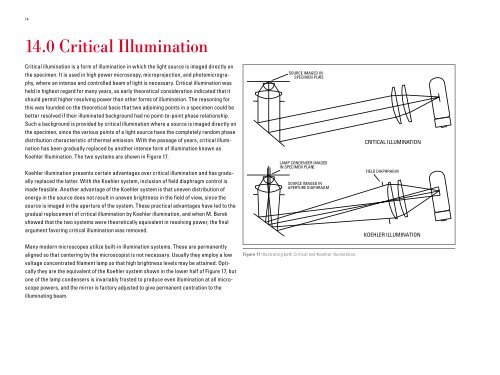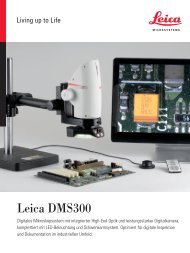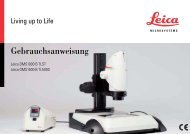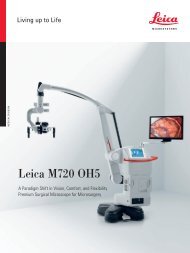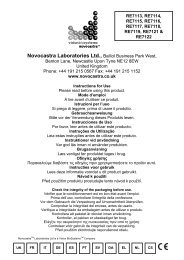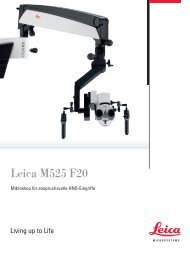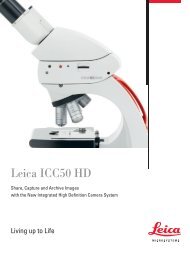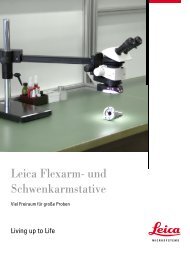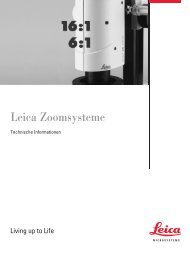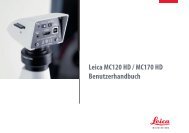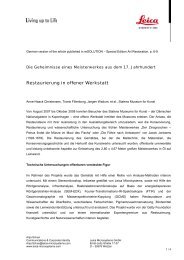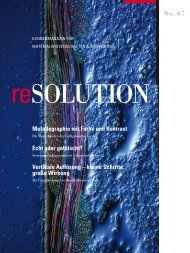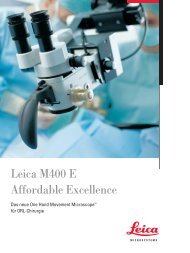The Theory of the Microscope - Leica Microsystems
The Theory of the Microscope - Leica Microsystems
The Theory of the Microscope - Leica Microsystems
Create successful ePaper yourself
Turn your PDF publications into a flip-book with our unique Google optimized e-Paper software.
14<br />
14.0 Critical Illumination<br />
Critical illumination is a form <strong>of</strong> illumination in which <strong>the</strong> light source is imaged directly on<br />
<strong>the</strong> specimen. It is used in high power microscopy, microprojection, and photomicrography,<br />
where an intense and controlled beam <strong>of</strong> light is necessary. Critical illumination was<br />
held in highest regard for many years, as early <strong>the</strong>oretical consideration indicated that it<br />
should permit higher resolving power than o<strong>the</strong>r forms <strong>of</strong> illumination. <strong>The</strong> reasoning for<br />
this was founded on <strong>the</strong> <strong>the</strong>oretical basis that two adjoining points in a specimen could be<br />
better resolved if <strong>the</strong>ir illuminated background had no point-to-point phase relationship.<br />
Such a background is provided by critical illumination where a source is imaged directly on<br />
<strong>the</strong> specimen, since <strong>the</strong> various points <strong>of</strong> a light source have <strong>the</strong> completely random phase<br />
distribution characteristic <strong>of</strong> <strong>the</strong>rmal emission. With <strong>the</strong> passage <strong>of</strong> years, critical illumination<br />
has been gradually replaced by ano<strong>the</strong>r intense form <strong>of</strong> illumination known as<br />
Koehler Illumination. <strong>The</strong> two systems are shown in Figure 17.<br />
Koehler illumination presents certain advantages over critical illumination and has gradually<br />
replaced <strong>the</strong> latter. With <strong>the</strong> Koehler system, inclusion <strong>of</strong> field diaphragm control is<br />
made feasible. Ano<strong>the</strong>r advantage <strong>of</strong> <strong>the</strong> Koehler system is that uneven distribution <strong>of</strong><br />
energy in <strong>the</strong> source does not result in uneven brightness in <strong>the</strong> field <strong>of</strong> view, since <strong>the</strong><br />
source is imaged in <strong>the</strong> aperture <strong>of</strong> <strong>the</strong> system. <strong>The</strong>se practical advantages have led to <strong>the</strong><br />
gradual replacement <strong>of</strong> critical illumination by Koehler illumination, and when M. Berek<br />
showed that <strong>the</strong> two systems were <strong>the</strong>oretically equivalent in resolving power, <strong>the</strong> final<br />
argument favoring critical illumination was removed.<br />
Many modern microscopes utilize built-in illumination systems. <strong>The</strong>se are permanently<br />
aligned so that centering by <strong>the</strong> microscopist is not necessary. Usually <strong>the</strong>y employ a low<br />
voltage concentrated filament lamp so that high brightness levels may be attained. Optically<br />
<strong>the</strong>y are <strong>the</strong> equivalent <strong>of</strong> <strong>the</strong> Koehler system shown in <strong>the</strong> lower half <strong>of</strong> Figure 17, but<br />
one <strong>of</strong> <strong>the</strong> lamp condensers is invariably frosted to produce even illumination at all microscope<br />
powers, and <strong>the</strong> mirror is factory adjusted to give permanent centration to <strong>the</strong><br />
illuminating beam.<br />
SOURCE IMAGED IN<br />
SPECIMEN PLATE<br />
LAMP CONDENSER IMAGED<br />
IN SPECIMEN PLANE<br />
SOURCE IMAGED IN<br />
APERTURE DIAPHRAGM<br />
Figure 17 Illustrating both Critical and Koehler illumination.<br />
CRITICAL ILLUMINATION<br />
FIELD DIAPHRAG M<br />
KOEHLER ILLUMINATION


